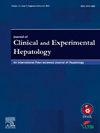Multiomics Analysis and Machine Learning-based Identification of Molecular Signatures for Diagnostic Classification in Liver Disease Types Along the Microbiota-gut-liver Axis
IF 3.2
Q2 GASTROENTEROLOGY & HEPATOLOGY
Journal of Clinical and Experimental Hepatology
Pub Date : 2025-03-24
DOI:10.1016/j.jceh.2025.102552
引用次数: 0
Abstract
Background
Liver disease, responsible for around two million deaths annually, remains a pressing global health challenge. Microbial interactions within the microbiota–gut–liver axis play a substantial role in the pathogenesis of various liver conditions, including early chronic liver disease (eCLD), chronic liver disease (CLD), acute liver failure (ALF), acute-on-chronic liver failure (ACLF), non-alcoholic fatty liver disease (NAFLD), steatohepatitis, and cirrhosis. This study aimed to identify key molecular signatures involved in liver disease progression by analyzing transcriptomic and gut microbiome data, and to evaluate their diagnostic utility using machine learning models.
Methods
Transcriptomic analysis identified differentially expressed genes (DEGs) that, when integrated with regulatory elements microRNAs, transcription factors, receptors, and the gut microbiome highlight disease-specific molecular interactions. To assess the diagnostic potential of these molecular signatures, a two-step analysis involving principal component analysis (PCA) and Random Forest classification was conducted, achieving accuracies of 75% for ALF and 89% for NAFLD. Additionally, machine learning algorithms, including K-neighbors, multi-layer perceptron (MLP), decision tree, Random Forest, logistic regression, gradient boosting, CatBoost, Extreme Gradient Boosting (XGB), and Light Gradient Boosting Machine (LGBM), were applied to gene expression data for ALF and NAFLD.
Results
Key genes including CLDN14, EGFR, GSK3B, MYC, and TJP2, alongside regulatory miRNAs let-7a-5p, miR-124-3p, and miR-195-5p and transcription factors NFKB1 and SP1 may be suggested as critical to liver disease progression. Additionally, gut microbiota members, Dictyostelium discoideum and Eikenella might be novel candidates associated with liver disease, highlighting the importance of the gut-liver axis. The Random Forest model reached 75% accuracy and 83% area under the curve for ALF, while NAFLD classification achieved 100% accuracy, precision, recall, and area under the curve underscoring robust diagnostic potential.
Conclusion
This study establishes a solid foundation for further research and therapeutic advancement by identifying key biomolecules and pathways critical to liver disease. Additional experimental validation is needed to confirm clinical applicability.

多组学分析和基于机器学习的肝脏疾病诊断分类分子特征识别沿着微生物-肠道-肝脏轴
肝病每年造成约200万人死亡,是一项紧迫的全球卫生挑战。微生物-肠-肝轴内的微生物相互作用在各种肝脏疾病的发病机制中起着重要作用,包括早期慢性肝病(eCLD)、慢性肝病(CLD)、急性肝衰竭(ALF)、急性对慢性肝衰竭(ACLF)、非酒精性脂肪性肝病(NAFLD)、脂肪性肝炎和肝硬化。本研究旨在通过分析转录组学和肠道微生物组数据来识别参与肝脏疾病进展的关键分子特征,并使用机器学习模型评估其诊断效用。方法转录组学分析发现,当与调控元件microrna、转录因子、受体和肠道微生物组结合时,差异表达基因(DEGs)会突出疾病特异性的分子相互作用。为了评估这些分子特征的诊断潜力,进行了包括主成分分析(PCA)和随机森林分类的两步分析,ALF的准确率为75%,NAFLD的准确率为89%。此外,将k近邻、多层感知器(MLP)、决策树、随机森林、逻辑回归、梯度增强、CatBoost、极端梯度增强(XGB)和光梯度增强机(LGBM)等机器学习算法应用于ALF和NAFLD的基因表达数据。结果关键基因包括CLDN14、EGFR、GSK3B、MYC和TJP2,以及调节mirna let-7a-5p、miR-124-3p和miR-195-5p以及转录因子NFKB1和SP1可能被认为是肝病进展的关键基因。此外,肠道微生物群成员,盘状盘基钢菌和艾肯菌可能是与肝脏疾病相关的新候选者,突出了肠-肝轴的重要性。随机森林模型对ALF的准确率达到75%,曲线下面积达到83%,而NAFLD分类的准确率、精密度、召回率和曲线下面积达到100%,强调了稳健的诊断潜力。结论本研究确定了肝脏疾病的关键生物分子和通路,为进一步研究和治疗奠定了坚实的基础。需要进一步的实验验证来确认临床适用性。
本文章由计算机程序翻译,如有差异,请以英文原文为准。
求助全文
约1分钟内获得全文
求助全文
来源期刊

Journal of Clinical and Experimental Hepatology
GASTROENTEROLOGY & HEPATOLOGY-
CiteScore
4.90
自引率
16.70%
发文量
537
审稿时长
64 days
 求助内容:
求助内容: 应助结果提醒方式:
应助结果提醒方式:


